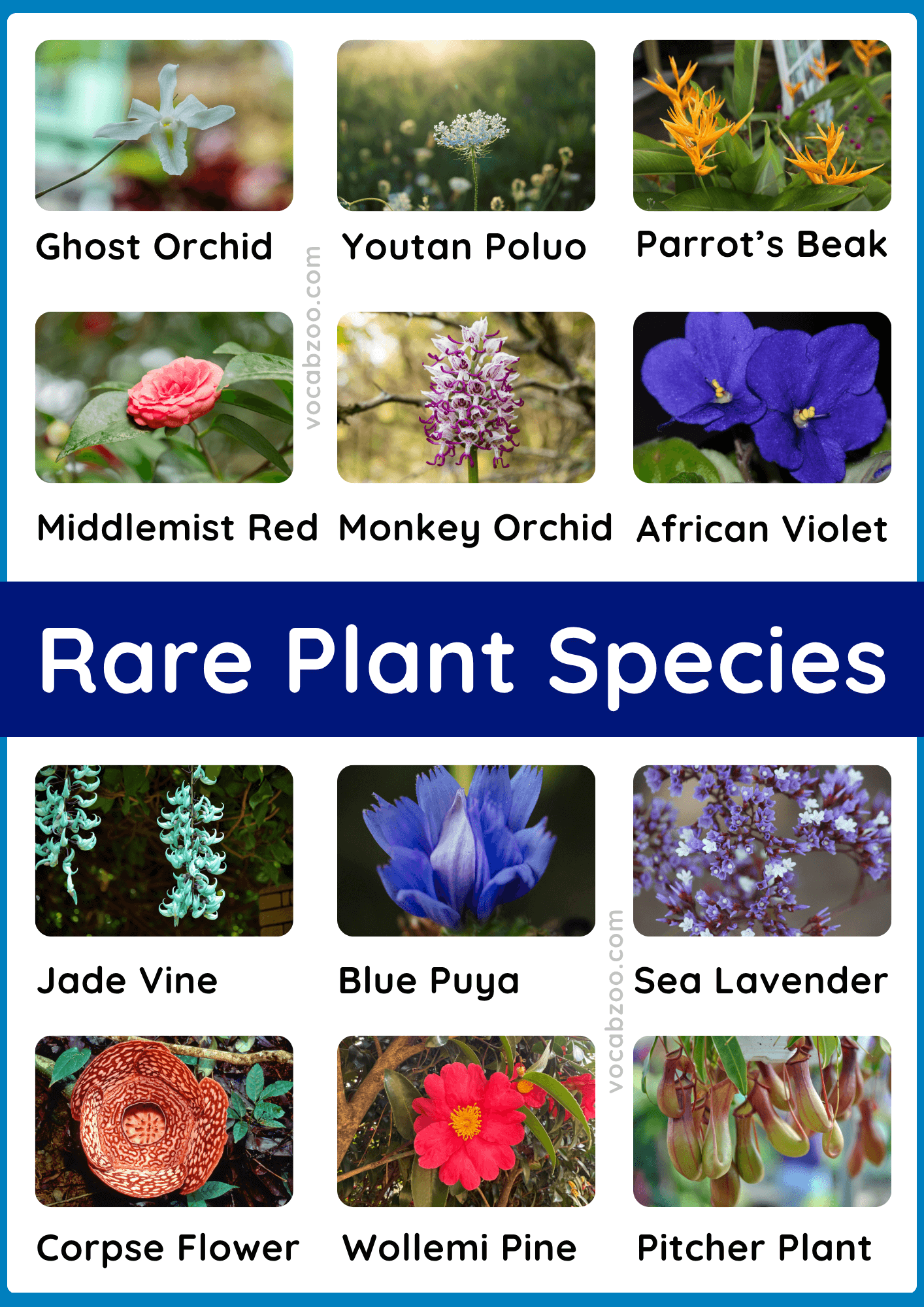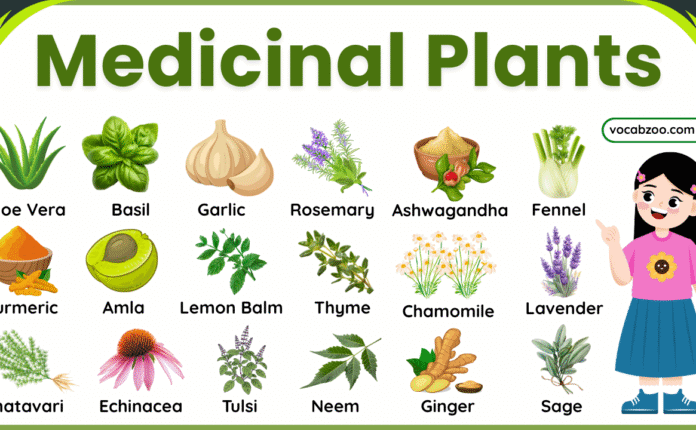Have you ever heard of plants that are so unique and hard to find that only a few still exist today? These are called rare plant species. They are nature’s hidden gems — beautiful, delicate, and often endangered. In this article, we’ll learn the names of 35+ rare plant species in English, their meanings, and why they are so special.
What Are Rare Plant Species?
Rare plant species are plants that are found in very few places on Earth. They are not common like roses or sunflowers. Some grow only in one country or even in one small area.
These plants may be rare because:
- Their environment has changed
- People have destroyed their natural homes
- They grow very slowly or have low seed survival
In simple words, rare plants are special kinds that we must protect so they don’t disappear forever.
Importance of Rare Plants
Rare plants play a big role in keeping nature balanced. They:
- Help maintain clean air and soil
- Are used in traditional medicines
- Support animals and insects that depend on them
- Add to the beauty and variety of our planet
Without them, many other living things could also vanish.
List of Rare Plant Species Names in English
Here are some of the world’s rarest plant species with descriptions:
| Plant Name | Type | Description |
|---|---|---|
| Middlemist Red | Flower | A bright pink-red flower; one of the rarest plants on Earth. |
| Ghost Orchid | Flower | A white, leafless orchid found in humid forests; very rare to see. |
| Jellyfish Tree | Tree | Grows only in Seychelles; its fruits look like jellyfish. |
| Corpse Flower | Flower | Known for its strong smell; blooms once in several years. |
| Rafflesia Arnoldii | Flower | The largest flower in the world; has a strong odour to attract insects. |
| Western Underground Orchid | Flower | Found in Australia; blooms completely underground. |
| Welwitschia Mirabilis | Shrub | Grows in African deserts; can live over 1,000 years. |
| Encephalartos Woodii | Tree | An ancient cycad plant; now extinct in the wild. |
Rare Flower Species
Blue Puya
A beautiful turquoise flower from the Andes Mountains.
Franklin Tree
Discovered in the 1700s; no longer grows in the wild.
Snowdonia Hawkweed
Found only on a few mountain cliffs.
Youtan Poluo
A tiny white flower said to bloom once every 3,000 years, known from ancient legends and myths.
Kadupul Flower
A night-blooming flower from Sri Lanka that fades before sunrise and cannot be picked without wilting.
Parrot’s Beak (Lotus berthelotii)
Bright red petals shaped like a parrot’s beak; very rare and mostly found in the Canary Islands.
Choco Orchid
A rare orchid from Ecuador that grows only in humid forests with limited sunlight.
Rothschild’s Slipper Orchid
One of the most expensive orchids in the world, native to Borneo’s rainforests.
Campion (Silene tomentosa)
Found only on Gibraltar’s rocky cliffs; once thought extinct but rediscovered.
Chocolate Cosmos
Dark brown flower with a rich chocolate scent; extinct in the wild, survives in cultivation.
Green Jade Vine
A tropical vine with turquoise hanging flowers; rare and difficult to grow outside its native area.
Attenborough’s Pitcher Plant
A carnivorous plant from the Philippines that traps insects inside its pitcher-shaped cups.
Himalayan Blue Poppy
A stunning blue flower found in the Himalayas, admired for its beauty but hard to cultivate.
Rare Trees and Shrubs
Pennantia Baylisiana
A small tree from New Zealand with only one wild specimen.
Kokia Cookei
A rare Hawaiian tree with bright red blossoms.
Bois Dentelle
An endangered tree with delicate white flowers.
Dragon’s Blood Tree
Native to Yemen’s Socotra Island, this tree produces red sap called “dragon’s blood.”
Grandidier’s Baobab
Giant tree from Madagascar, endangered due to habitat loss and changing weather.
Wollemi Pine
Ancient tree thought extinct until rediscovered in Australia in 1994.
Bristlecone Pine
Some of the oldest trees on Earth, capable of living for thousands of years.
Monkey Puzzle Tree
A rare and ancient tree from Chile with sharp, scale-like leaves.
St. Helena Gumwood
Endangered tree from St. Helena Island; also the national tree of the island.
Pua Ala (Hibiscadelphus woodii)
Hawaiian shrub with yellow-orange flowers, extinct in the wild but grown in nurseries.
Hinton’s Oak (Quercus hintonii)
Rare oak tree from Mexico with reddish bark and uniquely shaped leaves.
African Blackwood (Dalbergia melanoxylon)
Dark, dense wood used in musical instruments; rare due to overharvesting.
Alerce (Fitzroya cupressoides)
A giant evergreen tree from South America; one of the oldest living tree species.
Rare Desert and Unusual Plants
Titan Arum (Amorphophallus titanum)
Huge flower that blooms rarely and gives off a strong smell like rotting flesh.
Baobab Tree (Adansonia grandidieri)
Known as the “Tree of Life,” found in dry forests of Madagascar and stores water in its trunk.
Queen of the Andes (Puya raimondii)
The tallest flowering plant in the world, blooms once in 100 years, then dies.
Living Stones (Lithops)
Tiny desert plants that look like stones to protect themselves from animals.
Ghost Plant (Monotropa uniflora)
A pale white, non-green plant that grows in dark forests without sunlight.
Blue Vanda Orchid
A striking blue orchid that is very rare and difficult to grow outside its natural habitat.
Pitcher Plant of Borneo (Nepenthes rajah)
A large carnivorous plant that traps insects and even small animals.
Night-Blooming Cereus
Cactus that opens its fragrant flowers only once a year at night.
King’s Holly (Lomatia tasmanica)
Found in Tasmania; reproduces by cloning instead of seeds, making it very unique.
Lady’s Slipper Orchid
A beautiful orchid shaped like a slipper; rare and protected in many countries.
Rare Aquatic and Tropical Plants
Victoria Amazonica
Giant water lily from the Amazon River; its leaves can hold the weight of small animals.
Mangarahara Cichlid Plant Symbiote
A rare plant-algae relationship found in Madagascar’s river systems.
Waterwheel Plant (Aldrovanda vesiculosa)
A floating carnivorous plant that traps small aquatic insects.
Rhododendron camtschaticum
A rare Arctic flower that can survive in freezing conditions.
Tahina Palm (Tahina spectabilis)
A tall palm from Madagascar that blooms once in its lifetime and then dies.
Reasons Plants Become Rare
There are several causes that make plant species rare:
- Deforestation – cutting down forests removes their homes.
- Climate change – changes in temperature and rainfall harm their growth.
- Over-collection – some rare plants are taken for decoration or trade.
- Pests and diseases – destroy natural populations of plants.
🌱 When one plant disappears, the whole environment feels the loss.
How to Protect Rare Plants
We can all help to save rare plant species by taking small steps:
- Avoid buying wild plants taken from nature.
- Support botanical gardens and plant nurseries that protect rare species.
- Join or donate to environmental groups.
- Learn and teach others about the value of nature.
Simple actions today can protect rare plants for tomorrow.
Summary on Rare Plant Species
Rare plant species are nature’s treasures — beautiful, uncommon, and important. By learning their English names, we understand more about our world’s biodiversity. Protecting them means protecting the future of our planet.
🌿 Every rare plant saved is a small victory for nature.

FAQs
What are rare plant species?
Rare plant species are plants that exist in very small numbers or grow in limited areas. They are uncommon and often protected to stop them from disappearing.
Why are some plants considered rare?
Plants become rare due to deforestation, climate change, or over-collection. When their natural homes are destroyed, fewer of them can survive.
What are some examples of rare plant species?
Examples include the Ghost Orchid, Middlemist Red, Corpse Flower, and Rafflesia Arnoldii. These plants are hard to find and grow in special environments.
Where can I find rare plant species?
Rare plant species can be seen in botanical gardens, protected forests, or national parks where they are safely grown and studied.
Why are rare plants important?
Rare plants help maintain a healthy environment, support wildlife, and are sometimes used in medicine or research. They are essential for nature’s balance.
How can we protect rare plants?
We can protect rare plants by avoiding illegal trade, supporting reforestation, and learning about conservation programmes that save endangered species.
Read More



